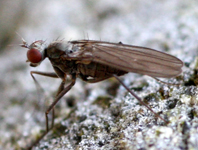Abstract
Esemephe peba sp. nov is described. This newly discovered species represents the first record of Cossyphodini from Brazil. It is also the second species of the genus Esemephe Steiner and differs from the type species in antennal, elytral and aedeagal structure. Descriptions of male and female terminalia are provided, as well as the revised diagnosis and distributional map for Esemephina. Finally, an updated identification key to the World genera of Cossyphodini is proposed.
References
Araujo, L.S. & Lopes-Andrade, C. (2016) A new species of Falsocis (Coleoptera: Ciidae) from the Atlantic Forest biome with new geographic records and an updated identification key for the species of the genus. Zoologia, 33, 1–6.
https://doi.org/10.1590/S1984-4689zool-20150173
Brauns, H. (1901) Cossyphodites Brauns nov. gen. Cossyphodidarum Wasm. Annalen des k. k. naturhistorischen Hofmuseums Wien, 16, 91–96.
Matthews, E.G. (2000) Origins of Australian arid-zone tenebrionid beetles. Invertebrate Taxonomy, 14, 941–951.
https://doi.org/10.1071/IT00021
Matthews, E.G., Lawrence, J.F., Bouchard, P., Steiner Jr., W.E. & Ślipiński, A. (2010) 11.14. Tenebrionidae Latreille, 1802. In: Leschen, R.A.B., Beutel, R.G. & Lawrence, J.F. (Eds.), Handbook of Zoology. A Natural History of the Phyla of the Animal Kingdom. Vol. IV. Arthropoda: Insecta. Part 38. Coleoptera, Beetles. Vol. 2. Systematics (Part 2). Walter de Gruyter, Berlin, pp. 574–659.
https://doi.org/10.1515/9783110911213.574
Morrone, J.J. (2014) Biogeographical regionalisation of the Neotropical region. Zootaxa, 3782 (1), 001–110.
https://doi.org/10.11646/zootaxa.3782.1.1
Morrone J.J. (2015a) Biogeographical regionalisation of the world: a reappraisal. Australian Systematic Botany, 28, 81–90.
https://doi.org/10.1071/SB14042
Morrone, J.J. (2015b) Biogeographical regionalisation of the Andean region. Zootaxa, 3936 (2), 207–236.
https://doi.org/10.11646/zootaxa.3936.2.3
Schawaller, W. (2006) First record of the subfamily Cossyphodinae (Coleoptera, Tenebrionidae) from the Socotra Archipelago. Fauna of Arabia, 21, 247–250.
Schawaller, W. (2013) Cossyphodini (Coleoptera: Tenebrionidae: Pimeliinae) in South Africa, Namibia and adjacent regions: New species and records, key to genera, and Old World species catalogue. Zootaxa, 3721 (4), 351–364.
https://doi.org/10.11646/zootaxa.3721.4.3
Schawaller, W., Sharaf, M.R. & Aldawood, A.S. (2011) The Tribe Cossyphodini (Coleoptera: Tenebrionidae: Pimeliinae) of the Arabian Peninsula, with Notes on Biology and Ecology. Annales Zoologici, Warszawa, 61 (3), 493–444.
https://doi.org/10.3161/000345411x603300
Steiner Jr., W.E. (1980) A New Tribe, Genus, and Species Of Cossyphodine From Peru (Coleoptera, Tenebrionidae). Proceedings of the Entomological Society of Washington, 82, 384–395.
Wasmann, S.J. (1899) Neue Termitophilen und Myrmecophilen aus Indien. Deutsche entomologische Zeitschrift, 1899, 145–169.
https://doi.org/10.1002/mmnd.48018990135
Watt, J.C. (1974) A revised subfamily classification of Tenebrionidae (Coleoptera). New Zealand Journal of Zoology, 1 (4), 381–452.
https://doi.org/10.1080/03014223.1974.9517846
Wick, M. (2010) GeoNames Home. Online. Switzerland: The GeoNames Geographical Database. Available from: http://www.geonames.org (accessed 5 November 2015)

